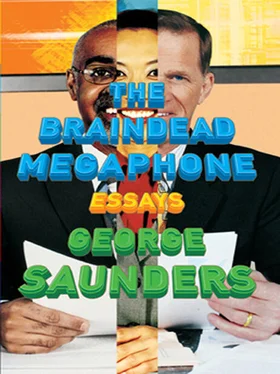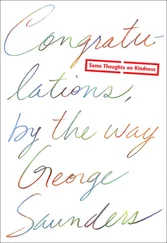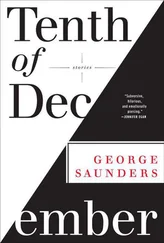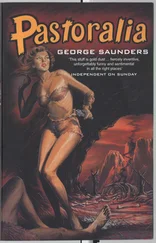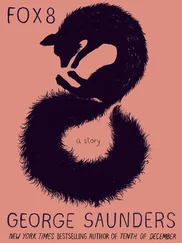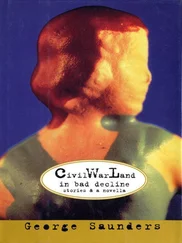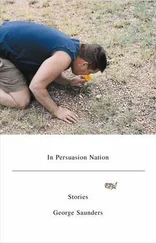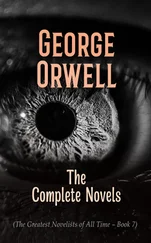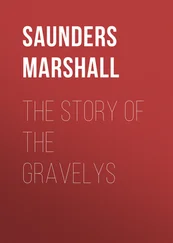So: part of the fun of “The School” is going to be the gradual unveiling of a series of Things That Die.
But then immediately — writing short stories is very hard work — Barthelme is in trouble. The reader is already, here at the beginning of paragraph four, subtly ready to be bored. The reader knows The Pattern — and is suddenly wary that The Pattern may turn out to be all there is.
If I say: “I ate a small candy, then a bigger candy, then a candy the size of a room, then a candy the size of Montana…,” you get the idea. You know where I’m headed. There’s a certain pleasure in this: you’re in on the joke, your mind knows the general shape of the fun to be expected. But if I just keep going (“I ate a candy the size of the United States! The size of North America! The size of—” even typing this is getting tiresome, although I would have liked to get at least as far as “I ate a piece of candy the size of Uranus!”), you are going to start to dislike me. Why? Because I’m condescending. I’m assuming that this simple, linear pattern is enough to interest you. I’m treating you like a dumb beast, endlessly fascinated by a swinging weight on a cord.
A STORY IS MADE OF THINGS THAT FLING OUR LITTLE CAR FORWARD
When I was a kid I had one of these Hot Wheels devices designed to look like a little gas station. Inside the gas station were two spinning rubber wheels. One’s little car would weakly approach the gas station, then be sent forth by the spinning rubber wheels to take another lap around the track or, more often, fly out and hit one’s sister in the face.
A story can be thought of as a series of these little gas stations. The main point is to get the reader around the track; that is, to the end of the story. Any other pleasures a story may offer (theme, character, moral uplift) are dependent upon this.
In this case, once we’ve discerned the pattern, Barthelme is going to fling us forward via a series of surprises; each new pattern-element is going to be introduced in a way we don’t expect, or with an embellishment that delights us. For example: when it is time for the tropical fish to be introduced, i.e., to die, Barthelme capitalizes on our knowledge (born of many carnival-won fish) that killing a tropical fish is basically a fait accompli once you’ve acquired one (“Those numbers, you look at them crooked and they’re belly-up on the surface.”). This constitutes a gas station because, in the process of advancing the pattern, he has given us a little something extra: a laugh, yes, but more important, an acknowledgment that the writer is right there with us — he knows where we are, and who we are, and is involved in an intimate and respectful game with us. I think of this as the motorcycle-sidecar model of reading: writer and reader right next to one another, leaning as they corner, the pleasure coming from the mutuality and simultaneity of the experience.
Likewise, there is a little gas station at the beginning of paragraph seven, when suddenly, from Dead Puppy, we leap to Dead Korean Orphan. This gas station has to do with the boldness of the escalation: Barthelme’s refusal to flinch at the logic of his own pattern. Some part of art, certainly of Barthelme’s art, involves the simple pleasure of watching someone be audacious. Another little audacity-related gas station — actually a series of gas stations, seeded throughout the story — is the pleasure we get from the narrator’s stuttering, fragmented syntax, a pleasure which comes in part from our awareness that this syntax is not exactly necessary ; it is, yes, character-indicating, but mostly it’s funny, and also impressive: we take pleasure in how well it’s done. Another hidden pleasure of the story is the way that the pattern is not — if I could say it this way— load-bearing. A lesser writer, who believes writing is about knowing, control, and mastery, told to create a pattern in which things die, might (mis)understand his job to be: designing and executing an extremely meaningful pattern. He would spend a lot of time trying to decide, in advance, the answers to questions like, “In what order should I have the things die?” and “What will I have cause the deaths?” and “How is the main character to be implicated in, and changed by, these events?”
Mr. Lesser Writer, in other words, realizing with joy that he has a pattern to work with, sits down to do some Thinking. Barthelme proceeds in a more spontaneous, vaudevillian manner. He knows that the pattern is just an excuse for the real work of the story, which is to give the reader a series of pleasure-bursts. The story, then, can be seen as a series of repetitions of one event: the reader leaves a little gas station at high speed, looking forward to the next one.
ENDING IS STOPPING WITHOUT SUCKING
So: if the writer can put together enough gas stations, of sufficient power, distributed at just the right places around the track, he wins: the reader works his way through the full execution of the pattern, and is ready to receive the ending of the story.
Because all along, a question has been rising: OK, we’ve been feeling, this is funny, this is enjoyable, but how and when is it going to start being literature? How’s he going to take this Marx Brothers — quality romp and convert it at the last minute into a Post-Modernist Masterpiece?
How, in other words, is this story going to mean ?
The land of the short story is a brutal land, a land very similar, in its strictness, to the land of the joke. When I tell a joke, everyone hearing knows that the joke is going to culminate in a punch line, and the intention of the punch line is to make them laugh. If it doesn’t, the joke is dumb, and I’m a dork. Likewise, when a person presumes to tell a literary short story, everyone reading knows that it is going to culminate in an ending, and that the intention of the ending is to…
Well, hold on — what is the intention of the ending?
Or — the million-dollar question for any of us who has ever tried to complete a short story: When constitutes a sufficient ending? In other words, what does Barthelme have to do here, as he goes forth from the end of paragraph nine (which I consider the end of the Rising Action), so that we will continue to love him?
His first responsibility is to not do something that will make us groan. What will make us groan? Something that too neatly “answers to” his Pattern.
Say he ended it:
Then I came in one day, and all the kids were dead.
And all of a sudden I wasn’t feeling so good myself!
That was one bad semester!
THE END!
This is not a story ending, but the ending of a lousy after-dinner speech; it knows its own pattern too well, and has stuck with it mindlessly, to the bitter end. It has done (merely) what it set out to do — and we require more of our endings than this.
Einstein once said something along the lines of: “No worthy problem is ever solved within the plane of its original conception.” Touching on the same idea, a famous poet once said: “If you set out to write a poem about two dogs fucking, and you write a poem about two dogs fucking, then you’ve written a poem about two dogs fucking.”
What we want our ending to do is to do more than we could have dreamed it would do.
Sheesh.
No wonder there’s such a thing as writer’s block.
But Barthelme understands that what he has to do in this last page is keep doing what has worked so far in the story: he has to escalate. The story has, so far, been captivating us via its nervy continual progress along the axis labeled: Deaths, Increasing. By paragraph nine (parents have died, fellow students have died) Barthelme’s gone about as far along that axis as he can, and now understands that, to continue escalating, he has to leap to another axis. He seems to intuit that the next order of escalation has to be escalating escalation.
Читать дальше
